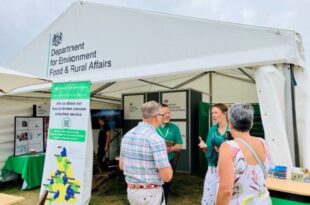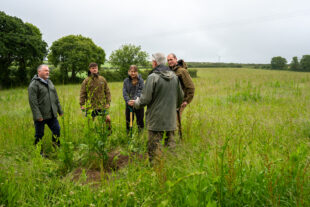https://defrafarming.blog.gov.uk/transcript-how-sfi-works-hand-in-hand-with-arable-crop-production/
Transcript: How SFI works hand in hand with arable crop production
Caroline Knox,SFI Arable Standard agreement holder,Marvel Farms, Isle of WightSo we're on the Isle of Wight. We're in the middle of the Isle of Wight. We farm 500 hectares, owned and rented land. It extends from here down through the Arreton Valley. Over the years in this land we've farmed potatoes, carrots, parsnips, we've done a lot of combinable crops. But now we just simply grow for a biogas plant.This is a cover crop drilled about 3 weeks ago after the first rain we'd had since almost April. It follows rye harvest in July. In an ideal world, this would have been planted in July-early August, and we would be chin-high in sunflowers and knee-high in phacelia by now. But because it was just so dry this year, we've only just got it in a few weeks ago.In a normal August-September, the sunflowers are in their full glory, there'd be bees buzzing everywhere. And along with the bees, of course, the birds, over the last few winters, it's been an incredible sight to see, really enjoying the biodiversity and the feedstock that's within this floralistic cover crop.This is buckwheat. This was only drilled about 3 weeks ago, so it is remarkable how quickly that's come up. Very late drilled this year, we had to wait for moisture, but it's pretty gratifying, what's growing. The buckwheat's already coming into flower and I think this phacelia will flower as well, it's hopefully going to come up with all the purple glory.There's that mixture of vetches, there's various normal farm weeds, there's chickwheat and fat hen, we've got linseed in here, there's some oat seed that we had left over, so it's quite a complicated mix. Our cover crops have really evolved over the years. When we first started looking at cover crops, it was just stubble turnips, which we saw as something which would stabilise the soil, provide ground cover.We were drawn to the soil standards on our farm because a lot of the actions in both the basic and the intermediate level, we were actually already doing, we'd already been evolving in that direction over the years.When it actually came to doing it, I looked online on GOV.UK. I think if you've had any experience of doing a BPS [Basic Payment Scheme] application or even a Countryside Stewardship application, it'll be very familiar to you. The ability to choose which fields was very straightforward, whether to go into basic or intermediate level. We ticked the boxes and it was quite a straightforward process. Soil is the foundation of our business.The soil standards is a way for people to start looking at improving soil carbon. With soil carbon comes soil health. With soil health comes productivity. My top tip is, look at the standards. Be open minded. You'll probably find you are doing a lot of these practices already. And look, if this is a way you can add some money to your bottom line to replace some of the uncertainty that has come with the decrease in BPS.This is an old map of the farm. The soil type varies from very sandy to quite a deep clay loam at the other end. The outcome of the soil standards is all about what's happening in the fields, but there is a degree of record-keeping required. It ties in nicely with what we've been doing already with nitrogen- vulnerable zones. So we just have a soil management plan. It charts each field, the soil type. We have soil analysed for NPK [Nitrogen, Phosphorus, Potassium] as routine and the soil type has been assessed over the years.So all this ties in with something we've done historically. But you can go out there with a spade, a digger, you can profile your own soil, and there's plenty of tools available to determine your soil type to fulfil the requirements of the scheme.



